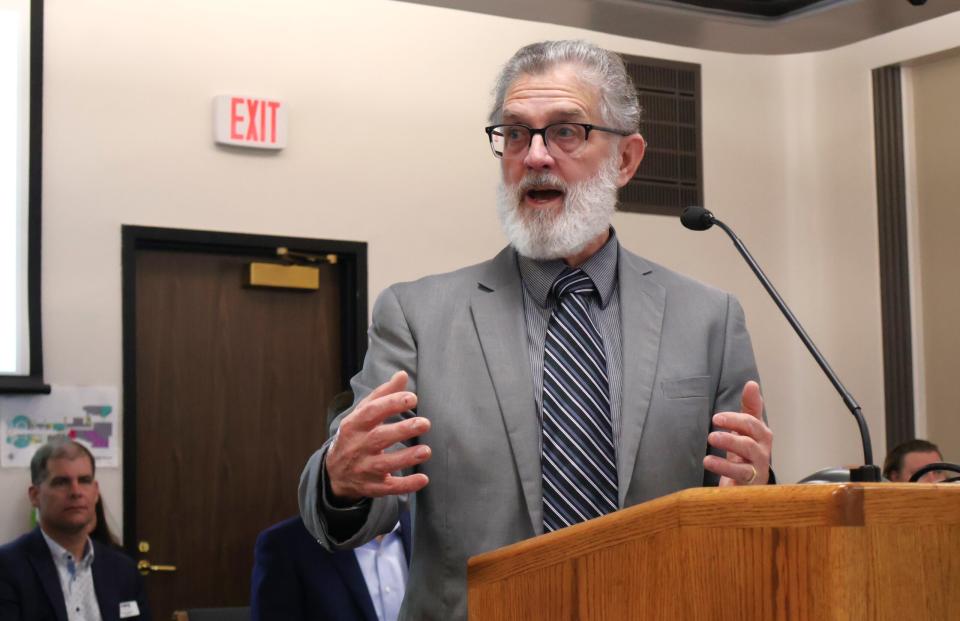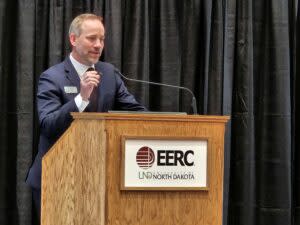Pilot projects seek to unlock enhanced oil recovery in North Dakota

A carbon dioxide injection site is shown in North Dakota. Carbon dioxide is one method of enhanced oil recovery. (Energy and Environmental Resource Center)
North Dakota’s top oil regulator recently issued a warning: the state’s oil production is in danger of falling into “terminal decline” by the mid-2030s without unlocking enhanced oil recovery.
But Lynn Helms, the director of North Dakota’s Department of Mineral Resources, also pointed to pilot projects that show promise for enhanced oil recovery that could lead to billions more barrels of oil.

Enhanced oil recovery, or EOR, means trying to squeeze more oil out of existing wells. That’s a challenge in North Dakota’s Bakken shale formation, where the oil is trapped inside rocks deep underground.
The Williston Basin Petroleum Conference that runs Tuesday through Thursday in Bismarck includes EOR presentations from representatives of Halliburton, Liberty Resources and Continental Resources.
One much-discussed EOR method is pumping carbon dioxide emissions from industrial sites into wells to force more oil to the wellhead, but there are other methods being explored.
One pilot project was from a startup company, EOR Etc., doing the first test of its technology on a well near Tioga.
Brian Schwanitz, president and co-founder of the company, said it has developed a technique to reinject gas and water that are byproducts of oil production back into the well. It also adds surfactants, or soaps, in a way that forces more oil out of the rock.
The same way that soap can wash oil off your hands, it can help move oil toward a well head.
In the first pilot project near Tioga, the technique was able to recover an extra 1,300 barrels of oil with just one injection cycle on one well.
When used on a larger scale, he said there would be multiple rounds of injections on multiple wells.
With horizontal drilling, a technology that helped launch the 2000s oil boom in North Dakota, wells are often grouped together, with several wells per pad.
The company’s EOR process could be used on each of the wells in succession and then back to the first well for another round of injections, Schwanitz said.
“So we can just go round robin around those (wells) and pressure them up,” Schwanitz said. As rejuvenated wells get a boost in production, the company can repeat the process on the other wells in the unit.
“Then come back to that first well again and keep doing that and getting more and more oil each time again,” Schwanitz said.
GET THE MORNING HEADLINES DELIVERED TO YOUR INBOX
He said the method is a low-cost, low-pressure and low-carbon footprint way of improving oil recovery that could be used on thousands of wells around the country.
The company was founded in 2019 and built its first injection system in 2021. Its first EOR test was done near Tioga. It has since done more tests in Colorado and Texas and will soon be starting another pilot project in Dunn County.
Schwanitz said he believes their technique would work in conventional wells, where there is a pool of oil, but shale formations like the Bakken hold greater potential.
“There is such a huge prize in unconventional wells,” Schwanitz said.
He said carbon dioxide also could be used with the company’s process but using gas produced from the well is likely cheaper.
Helms called EOR Etc. “highly innovative,” and said results from a second test round should be more promising.
Liberty Resources owns the well that EOR Etc. ran its pilot program on.
Helms, who spoke to legislators last month during a meeting of the Energy Development and Transmission Committee, said other companies with EOR pilot projects include Continental Resources and XTO, a subsidiary of ExxonMobil.
Hess said it also has run pilot EOR programs. Hess announced last October an agreement to be acquired by Chevron. They continue to operate separately until the deal closes.
EOR Etc. also worked with researchers at the Energy and Environmental Resource Center at the University of North Dakota on the project.
The EERC in April was awarded $11.6 million from the U.S. Department of Energy for an enhanced oil recovery project that will look at using oil wells to store carbon underground.
“These projects will study the ability to transition unconventional oil reservoirs into carbon storage reservoirs — reducing the carbon intensity of oil production while supporting our nationwide efforts to capture and permanently store carbon dioxide to slow the harmful effects of climate change,” said Brad Crabtree, assistant secretary of fossil energy and carbon management, who is from North Dakota.
EERC has announced it will work with Chord Energy on an EOR project.

“We are absolutely CO2 starved,” Charles Gorecki, CEO of the EERC told the North Dakota Petroleum Council in March about the need for gas for EOR. He said all the CO2 produced from industrial sites, such as power plants, would not be enough to fill the state’s needs.
Helms will retire at the end of June after serving as North Dakota’s top oil official since 1998. This spring the state hit the 5 billion Bakken barrel mark in production.
During his presentation to the legislative committee and the possibility of declining oil revenue in about a decade, Helms was asked about the accuracy of his past predictions.
“I guess I’ve always underestimated what North Dakota was capable of,” Helms replied.
This story has been updated to correct the status of the acquisition of Hess.
The post Pilot projects seek to unlock enhanced oil recovery in North Dakota appeared first on North Dakota Monitor.

